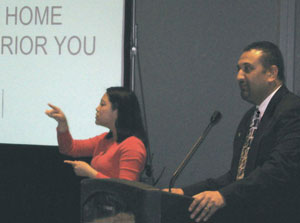Providing Auxiliary Aids and Services
A meeting that is accessible to people with sensory disabilities enables them to understand the meeting's presentations and to participate in the discussions.
- To provide effective communication for participants who are deaf or have hearing loss or who are blind or have low vision, meeting organizers may need to provide auxiliary aids and services, which may include for example:
- (for people who are deaf or have hearing loss) qualified interpreters, notetakers, realtime captioning, written materials, assistive listening systems, and open and closed captioning.
- (for people who are blind or have low vision) qualified readers, notetakers, texts on CD, audio recordings, Brailled materials, and large print materials.
A participant who is blind receives Brailled materials.
- Some of these aids (e.g., large print, written materials) can be produced by the meeting organizers while some will require a professional service provider. Find out which services are available in the local area, where to obtain them, and how long it takes to arrange for them. For help in locating service providers, call a local Center for Independent Living (CIL) or regional Disability and Business Technical Assistance Center (DBTAC). Additional Resources for Technical Assistance and Locating Accessibility Services
- When choosing a date for the meeting, make the length of time needed to contract for auxiliary aids and services a key factor in the date selection process. In some locations, for example, it can take several weeks to find and hire an interpreter or to have a document printed in Braille. If the aids and services are provided only after a request from a participant, also plan any invitation response deadlines to accommodate these time constraints. As soon as a participant makes a request for services, contact the appropriate provider of auxiliary aids or services to get the request filled. Be sure to ask what specific services or aids they prefer.
Note: If providing a particular auxiliary aid or service at the meeting will result in an undue burden (i.e., will cause significant difficulty or expense) for the organizers, the organizers are not required to provide that exact service. However, they must try to find an alternative auxiliary aid or service that will not result in an undue burden but will ensure that participants with disabilities can participate fully in the session. Talk with the participant to find the best solution. - Once the service provider is contracted, find out before the meeting what information is needed to do the job effectively. For example:
- Interpreters and real-time captioners will be better able to interpret and transcribe meeting proceedings if they can review ahead of time the agenda, speaker and participant list (for proper name spellings), written handouts, and background information about the meeting topic.
- A supplier of assistive listening systems will have to know if the person requesting services uses a hearing aid, has a cochlear implant, or does not wear a personal device but benefits from amplification.
- On the day of the meeting, introduce the service providers to the participants who requested the services. Talk with them all to ensure that seating, lighting, and equipment are in place for effective delivery of the services. For example, people who are deaf or have hearing loss need to see the interpreter throughout the meeting. If the room lights are lowered for audiovisual presentations, separate lighting on the interpreter may be needed. Ensure that assistive listening systems are in working order with sufficient battery power for the entire meeting.
- Many participants who are deaf or have hearing loss prefer to see both the interpreter and the speaker during a presentation. If the speaker is positioned at a podium in front of the room, it may be best to have the interpreter stand beside the podium. For other meeting formats and room arrangements, talk with the participants who are deaf or have hearing loss and the interpreters to find the best way to maintain the line of sight between them.



User Comments/Questions
Add Comment/Question